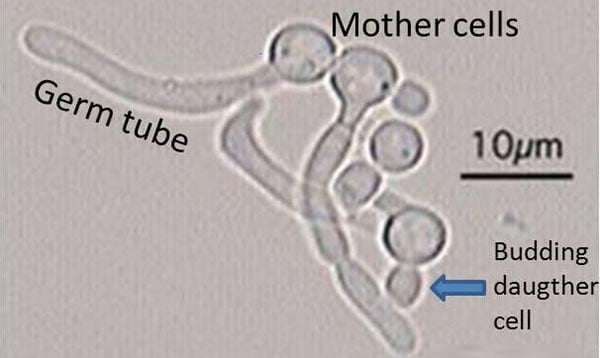Germ Tube Test is a screening test which is used to differentiate Candida albicans from other yeast. Germ tube (GT) formation was first reported by Reynolds and Braude in 1956. When Candida is grown in human or sheep serum at 37°C for 3 hours, they forms a germ tubes, which can be detected with a wet KOH films as filamentous outgrowth extending from yeast cells. It is positive for Candida albicans and Candida dubliniensis. Approximately 95 – 97% of Candida albicans isolated develop germ tubes when incubated in a proteinaceous media.

Principle of Germ Tube Test
Formation of germ tube is associated with increased synthesis of protein and ribonucleic acid. Germ Tube solutions contains tryptic soy broth and fetal bovine serum, essential nutrients for protein synthesis. It is lyophilized for stability. Germ tube is one of the virulence factors of Candida albicans. This is a rapid test for the presumptive identification of C. albicans.
Procedure of Germ Tube Test
- Put 0.5 ml of sheep or human serum into a small tube.
Note: Fetal bovine serum can also be used instead of human serum. - Using a Pasteur pipette, touch a colony of yeast and gently emulsify it in the serum.
Note: Too large of an inoculum will inhibit germ tube formation. - Incubated the tube at 37°C for 2 to 4 hours.
- Transfer a drop of the serum to a slide for examination.
- Coverslip and examine microscopically under low and high power objectives.
Results and Interpretation of Germ Tube Test

Positive Test: A short hyphal (filamentous) extension arising laterally from a yeast cell, with no constriction at the point of origin. Germ tube is half the width and 3 to 4 times the length of the yeast cell and there is no presence of nucleus. Examples: Candida albicans and Candida dubliniensis
Negative Test: No hyphal (filamentous) extension arising from a yeast cell or a short hyphal extension constricted at the point of origin. Examples: C. tropicalis, C. glabrata and other yeasts.
Quality Control in Germ Tube Test
Positive Control: C. albicans (ATCC 10231)
Negative Control: C. tropicalis (ATCC 13803), C. glabrata (ATCC 2001)
Limitations of Germ Tube Test
- C. tropicalis may form early pseudohyphae which may be falsely interpreted as germ tubes.
- The yeast formerly named Candida stellatoidea also produces germ tubes; however, it has been combined with C. albicans and no longer exists as separate species.
- This test is only part of the overall scheme for identification of yeasts. Further testing is required for definite identification.
Similar Posts:
- Normal Laboratory Values of Blood, Plasma, Serum, Urine, CSF and Stool
- Widal Test- Introduction, Principle, Procedure, Interpretation and Limitation
- Rapid Plasma Reagin (RPR) Test for the diagnosis of Syphilis
- Histoplasma Capsulatum – Habitat, Morphology, Epidemiology, Virulence Factors, Treatment + More

What is the importance of the germ tube in pathogenesis of candida albicans
If I perform germ tube formation with a mixed blood sample from different individuals, will it stop the formation of germ tube?
I am not sure,but when i used mixed serum i couldn’t find any germ tube ,but when i used single serum not from different persons for the same isolates i found germ tubes
how many candida cells should show germ tube formation per field
to call it postive test
at least 5 germ tubes in the field
Approximately 95 – 97% of Candida albicans isolated develop germ tubes in condition of a positive test.
Thank you so much.I learn new things today.I never knew “germ” was from the word “germination.
Which drugs treats the non albicans Candida?
for how long we can keep Humen /sheep serum in refrigerator prior to use? Temperature of storage?
2-8°c for 24-48 hr
Thank you so much, but I have 1 question. These two organism only have positive germ tube test?
What happens when you exceed on incubation time on germ tube, let’s say you leave it for 6 hours in a water bath
Need more grounded information about term “germ”. As known “germ” is not scietific based term. Terminology for “germ” is uncler by now. Yeasts are not equalent to germs, as well as yeast test is not the same as germ test. So “differential tube test” or another test name could be more perfect/suitable for use. Replay would be very helpfull, thanks.
Germ in this sense means to germinate. It has nothing to do with bacteria.
how do we do culture on skin scrapping?
Good one.
Also Growth at 45C on Chromagar Plate and PCR can be used to differentiate Candida albicans from and Candida dubliniensis.
Other differential test for candida species like suger fermentation test ?need informations about it.thank you very much